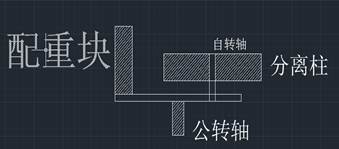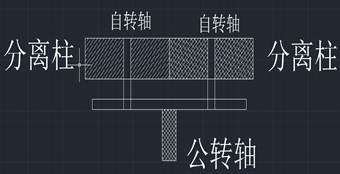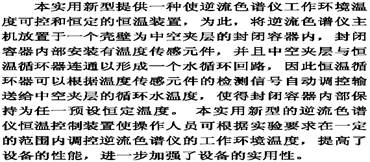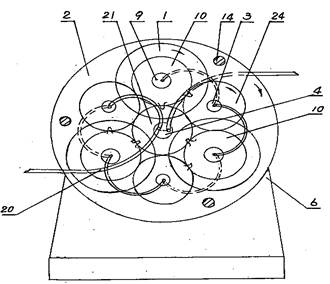J-type high-speed countercurrent chromatography evolution and future
2021-11-26 11:05:51
J -type high-speed countercurrent chromatography evolution and future
table of Contents
I. Overview... 3
Second, the key technology... 3
2.1 Separation column... 3
2.1.1 Single separation column... 3
2.1.2 Double separation column... 4
2.1.3 Three separation columns... 4
2.2 Pipeline Unwinding... 5
2.2.1 Unwinding the axis... 5
2.2.2 Rotary seal... 5
2.3 Shock Absorption System... 6
2.3.1 Traditional shock absorption... 6
2.3.2 Spring shock absorption... 6
2.4 Temperature Control System... 7
2.4.1 Circulating water bath... 7
2.4.2 Air Conditioning Refrigeration... 7
Third, the evolution process... 7
3.1 Single separation column + unwinding tube... 7
3.2 three separation column + unwinding tube... 8
3.3 multi-separation column + rotary seal... 8
Fourth, the development trend... 9
4.1 Large preparation volume... 9
4.2 Industrialization... 9
I. Overview
The J-type high-speed countercurrent chromatograph uses a multi-layer winding separation column to separate the material by centrifugal force generated by planetary revolution + rotation and the solubility difference of different substances in the upper and lower two-phase solvent. The advantages of high-speed countercurrent chromatography compared to conventional separation and purification methods are higher separation efficiency and larger preparation and lower solvent cost.
The internal core component of the J-type high-speed countercurrent chromatograph consists of at least one separation column, one revolution axis and one rotation axis. The operation mode is that the separation column rotates at a high speed around the rotation axis, and the whole revolves around the revolution axis at a high speed. In order to achieve a large amount of preparation and high separation efficiency, the industry has continuously explored the core components of the high-speed countercurrent chromatograph equipment and the mechanical structure inside the equipment, and the temperature control method.
Since the birth of the first high-speed countercurrent chromatograph in China, the development of high-speed countercurrent chromatograph technology in China has experienced three major stages.
1. High-speed countercurrent chromatograph with single separation column and unwinding tube
2. High-speed countercurrent chromatograph using three separation columns, unwinding tube and circulating water bath
3. High-speed countercurrent chromatograph using rotary seal unwinding, multi-separation column, compressor air conditioner direct cooling
In the above three development stages, the separation column design, the unwinding design and the temperature control design have played an important role.
Second, the key technology
The key technologies of high-speed countercurrent chromatograph include separation column design, unwinding design, damping system, and temperature control system design.
2.1 Separation column
The ratio of the rotation radius of the separation column to the revolution radius is called the β value. The β value has a decisive influence on the separation effect, and its size directly affects the separation effect, and the large β value can achieve high-efficiency distribution separation. On the other hand, the size and number of separation columns directly determine the amount of preparation, which also determines the stability and reliability of mechanical operation.
2.1.1 Single separation column
The structure of the single separation column is shown in the figure below. With a single separation column, the β value of the system can be maximized, and even β is greater than 1 across the axis of the central axis.

Although the range of β values ​​of such a single separation column model is broad, it requires a weight to be stable, and requires high mechanical stability. At the same time, if the column volume is to be increased, the preparation volume is increased, and the separation column volume and the corresponding weight column volume are required to increase the overall size of the machine, thereby reducing the stability and reliability of the system operation.
2.1.2 Double separation column
The single separation column weight is replaced by a separation column to form a double separation column system, which solves the balance problem and expands the machine capacity, but requires more pipelines for connection. The theoretical maximum β value of this model is 1. In practical applications, the β value cannot reach 1 actually due to design considerations such as separation column processing and winding and mechanical structural stability.
Its structure is shown below:

2.1.3 Three separation column
Compared with the double separation column, the three separation column is equivalent to an increase of one column volume, and the connection pipe is also increased accordingly. The theoretical maximum β value can reach 0.866, and the schematic diagram of the structure is as follows:

Keeping the radius of the revolution constant, the radius of rotation will decrease as the number of columns increases, and the column volume will also decrease. The theoretical maximum β value will also decrease accordingly. The four separation columns are only 0.707, which can not meet the minimum. The beta value requirement (general test requires a beta value of at least 0.8 or more).
In summary, because each additional separation column, the rotation radius decreases, resulting in a continuous decrease in column capacity. Therefore, from a reasonable mechanical design point of view, in order to meet the basic β value required for the experiment, the three separation columns are The highest number of columns that can be used in high speed countercurrent chromatography.
2.2 Pipeline unwinding
Because the high-speed countercurrent chromatograph is a continuous flow separation system, the pipeline runs through from beginning to end, and it needs high-speed rotary motion. Therefore, measures should be taken to solve the pipeline entanglement and the pipeline damage that is easy to occur after long-term use. And the problem of breakage, this is the unwinding technique.
2.2.1 Unwinding axis
The traditional unwinding method is to connect the PTFE hose to the winding shaft. The basic principle is as follows:

As shown in the figure, the arrow indicates the direction of rotation of the separation column, which is combined with a unwinding axis of the same speed but rotated in the opposite direction to complete the unwinding of the red pipe. During the operation, because the rotation speed is the same but the steering is reversed, the red pipeline will not be wound and broken due to the rotation. Finally, the unwinding shaft and the central shaft form the last unwinding pipeline, and the pipeline is led to the outside of the machine.
Because the column has two outlets at the outlet and the inlet, it needs to be unwound, that is, they can be formed into a pipeline from one end of the column, and can be unwound from both ends of the column, and then from both ends of the corresponding central axis. It leads to the outside of the machine.
2.2.2 Rotary seal
The rotary seal uses a rotary sealing joint to connect the separation column to the external piping. The structure is as follows:

When the separation column with rotary seal rotates at high speed, the rotary sealing joint is fixed, and the pipeline connecting the inlet or outlet of the column and the external pipeline form a set of unwinding system. The machine connecting pipe adopting this system is relatively fixed and its joint is stationary, no need to unwind the shaft, and there is no risk of damage. The columns are directly connected by connecting pipes and leading to the outside of the machine.
Although the PTFE hose can be subjected to various chemical corrosion, but the wear resistance and tensile strength are poor, it is easy to leak or even break under the action of mechanical rotation. The rotary sealing technology effectively solves the long-term high-speed countercurrent chromatograph. Pipeline leakage and fracture problems, and thus create space for improving the separation performance of high-speed countercurrent chromatographs.
2.2.2.1 System dead volume
High-speed countercurrent chromatograph equipment, which removes the effective column volume, can be called dead volume. These pipelines do not participate in the separation process, but only exist as necessary connecting pipelines, so the smaller the dead volume, the better. Often the most common method minimizes the presence of dead volume by simply selecting a thinner and shorter tube as the pressure allows, and the dead volume inside the machine is treated as designed. It is difficult to avoid it later.
Due to the existence of the unwinding axis, the traditional high-speed countercurrent chromatography cannot be connected in a straight line. It must be unwound by the unwinding axis. There is also a range requirement for the inner and outer diameters of the unwinding tube, which inevitably leads to more dead volume. The presence.
After the rotary sealing technology is adopted, a straight line connection can be adopted between the pipes, the dead volume can be reduced in the maximum range, and pipes of various materials can be replaced as needed. Since the connecting pipe does not participate in the unwinding rotation, even if it is replaced with a high-strength material pipe such as PEEK or stainless steel, it can be easily realized, which greatly improves the service life and the convenience of operation.
2.3 damping system
Since the high-speed countercurrent chromatograph needs high-speed rotation during operation, it will inevitably bring about certain vibration. Therefore, it is necessary to apply a shock absorption system inside the instrument to reduce the vibration during the operation of the instrument.
2.3.1 Traditional shock absorption
The traditional shock absorption scheme is to add a spring pad or the like at a fixed connection to reduce the force generated by the vibration. This kind of scheme can't achieve good practical results. The high-speed countercurrent chromatograph adopts the traditional shock absorption method. After a long running time, due to the intense vibration, the device is easily worn, the system life is reduced, and the separation effect may be affected.
2.3.2 Spring shock absorption
Although the simplified mechanical design can greatly reduce the vibration generated by the machine, due to the dynamic continuous flow liquid system, the internal balance of the machine will be broken during the operation, resulting in vibration and additional noise. In order to reduce this problem, Jiangyin Countercurrent Technology Co., Ltd. has created a set of shock-absorbing structure suitable for high-speed rotating centrifugal system through a large number of experiments, which greatly reduces the dynamic balance caused by asymmetry, and thus Jiangyin Countercurrent Technology Co., Ltd. It can include single separation column, two separation column, three separation column, and there is no theoretical limit on the size of the machine capacity, and the optimal running smoothness can be achieved by this system.
2.4 temperature control system
Accurate and efficient temperature control systems are also critical for high-speed countercurrent chromatographs because temperature has a large effect on the solubility and activity of specific chemicals. There are two main types of temperature control systems for high-speed countercurrent chromatograph systems, namely, circulating water bath systems and compressor air conditioning direct cooling systems.
2.4.1 Circulating water bath
The working mode of the circulating water bath is to wrap the main part through a hollow casing in a confined space, and then inject a certain temperature of water into the hollow casing through an external water bath thermostat to change the temperature of the casing, thereby controlling the rotation space of the main machine. The air temperature affects the solvent temperature in the separation column (refer to the relevant patent description below).

2.4.2 Compressor air conditioning direct cooling
The direct cooling method of the compressor air conditioner is to change the main part to an open structure and completely communicate with the inside of the machine; and install an industrial-grade temperature-controlled air-conditioning system in the machine casing to directly control the internal space of the machine, thereby finally achieving a constant host temperature. .
The control of the temperature of the host finally requires air as the medium to act on the separation column. The direct cooling of the compressor air conditioner is stronger than the temperature control water bath in terms of temperature change speed and capacity (the water bath has strong heating capacity, but the boiling point of the reagent used in countercurrent chromatography is high. Very low, so the working temperature is generally not more than 45 degrees); the open structure is simple and quick for checking the operation of the machine and daily maintenance; the water bath circulator as an external component adds extra cost and operation steps, and also moves the machine in the future. It creates no trouble; the integrated wall-mounted air conditioner is completely integrated with the machine and can be centrally controlled by the machine control system.
Third, the evolution process
With the development of separation column, unwinding mode, damping system, temperature control system related technology, the development of high-speed countercurrent chromatograph has also experienced from single separation column + unwinding tube, three separation column + unwinding tube, multiple separation column + Evolution of the rotary seal mode.
3.1 single separation column + unwinding tube
When the countercurrent chromatography technology was first introduced, the domestic high-speed countercurrent chromatograph manufacturer adopted a single-column column plus unwinding tube structure design countercurrent chromatograph. The common feature of this device is that the total volume of the column is small and the system runs with large vibration. High noise.
3.2 three separation column + unwinding tube
As the user's demand for the total volume of the high-speed countercurrent chromatograph increases, the domestic high-speed countercurrent chromatograph manufacturers begin to study the countercurrent chromatographs of multiple separation columns after the single separation column series. Before 2010, the unwinding tube was the only feasible unwinding method because the rotary sealing technology was not mature. Under this condition, the counter-current chromatograph of the double-separation column or the three-separation column and the unwinding tube became the industry. The research goal of the manufacturer.
Due to the mechanical principle problem, the unwinding axis will have the dynamic balance damage of the whole system, which is especially obvious under the condition of double separation column. Under the condition that the rotary sealing technology is not used, the solution of adding the three-column column to rewind the shaft relative to the double-separating column to add the rewinding axis will bring better system stability and reduce the vibration of the system during operation.
For this reason, although the use of a double separation column to add a winding axis relative to the three separation column to add a winding axis can simplify the complexity of the system to a certain extent, but due to the system instability problem is prominent, the industry generally uses three separation columns The implementation of the rewinding axis.
The three separate columns need to have at least 7 rotating shafts including 7 axes and 7 gears, and at least 8 connecting pipe connecting units, as shown in the following figure. This design greatly reduces the reliability of the machine. In addition, as described above, the use of three separation columns reduces the maximum beta value that the system can achieve, which in turn reduces separation efficiency.

The use of the three separation columns requires a large number of columns and a large volume of space. Therefore, the total volume of the column of the high-speed countercurrent chromatograph that is actually commercially available in the three separation columns is about 300 ml.
3.3 multi-separation column + rotary seal
In 2010, Jiangyin Countercurrent Technology Co., Ltd. successfully developed a unique rotary seal unwinding and spring damping technology, using rotary seal unwinding technology, because there is no need to unwind the shaft and not damage the overall dynamic balance of the machine, so the double separation column model It has the same stability as the three separation column models.
The double separation column design adopting the rotary sealing technology can satisfy the system operation stability and the total volume requirement of the cylinder on the one hand, and at the same time increase the β value of the system and greatly improve the separation efficiency.
Fourth, the development trend
4.1 Large preparation
Due to the emergence of rotary seal unwinding technology and the advancement of shock absorption and temperature control systems, in addition to the common countercurrent chromatographs of the total volume of conventional cylinders such as 300ml, 500ml, 1L, etc., larger countercurrent chromatographs such as 10L or more have become may.
4.2 Industrialization
Traditional countercurrent chromatographs are mostly used in the laboratory due to the limitation of total column volume and separation efficiency. In the future, with the maturity of large-volume high-speed countercurrent chromatographs, countercurrent chromatographs and related technologies must Will go out of the laboratory and enter large-scale industrial applications.
Quick Frozen Bun,Steamed Pork Dumplings,Fried Glutinous Rice,Spring Onion Rolls
Zhejiang Shanying Trading Co.,Ltd. , https://www.shanyingtrading.com